Gingerbread
Latest
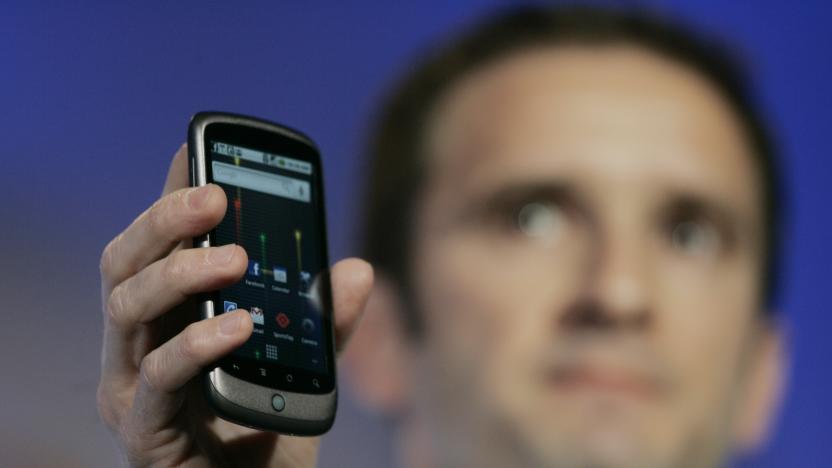
Google won't let you sign in with very old Android versions after September 27th
Google is cutting off the last support for old Android versions by blocking them from signing into key apps after September 27th.
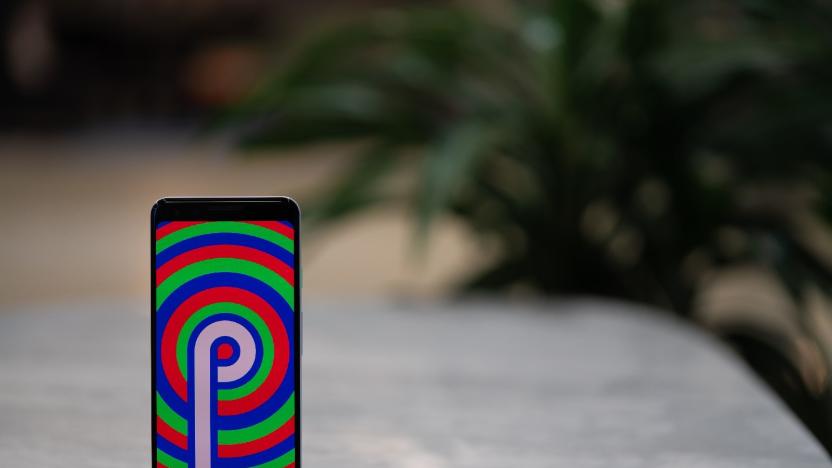
Android Pie hits 10 percent adoption two months ahead of its ancestors
Google left people in the dark regarding Android Pie's adoption for more than half a year, but it's finally lifting the curtain -- and Pie is doing better than its predecessors. Updated stats supplied to VentureBeat show that 10.4 percent of active users were using Pie after eight months. That may not sound like much, but it took about 10 months each for Oreo and Nougat to reach the 10 percent milestone. Google's efforts to spur Pie's uptake appear to have paid off, even if it's not a night-and-day difference.

Marshmallow is now on 10 percent of Android devices
The latest version of Android just hit a big, big milestone. Google's early June developer stats have revealed that Marshmallow is now on just over 10 percent of Android devices, representing a huge jump from just 2.3 percent in March. Notably, only some of that surge can be credited to people upgrading from Lollipop. While the not-quite-current version's adoption did go down (to 35.4 percent), the biggest declines in usage were for Jelly Bean and KitKat. In essence: many of those moving to Marshmallow may well have been replacing devices that were 3 or more years old.

Lollipop becomes the most popular version of Android
At last, there's a new flavor of Android on top of the heap. Google has published updated stats which show that Lollipop is now the most-used version of Android, snagging 36.1 percent of device share in early March versus former champ KitKat's 34.3 percent. It's a big milestone that suggests many Android users are using a reasonably modern take on the mobile platform.

Nearly a quarter of Android users are running Lollipop
Android Lollipop is enjoying its last, shining moment in the sun before Marshmallow arrives in earnest. Google's not-quite-current operating system now accounts for 23.5 percent of active Android users, a healthy 2.5-point boost from what you saw just one month ago. That's still trailing behind Jelly Bean (30.2 percent) and KitKat (38.9 percent), but it's clear that all those new devices and upgrades are starting to add up. The real question is whether or not that momentum will last. Marshmallow is arriving relatively quickly, and shouldn't suffer from the early performance and battery life woes that kept some people from upgrading last year. If the newer release catches on quickly, Lollipop might not reach the lofty adoption rates of its predecessors.

Android Lollipop is slowly (very slowly) hitting more devices
Lollipop didn't exactly take the Android world by storm when it first launched. Early adoption was slow enough that it made no real impact in usage share stats for the first couple of months. People are starting to take to Google's latest dessert-flavored OS, however -- it's finally on the official radar. Google's data now shows that about 1.6 percent of active Android users were using Lollipop as of the start of February. That's certainly not a lot, but it's clear that all those Nexuses and early Lollipop upgrades (most notably from HTC, LG and Motorola) count for something.
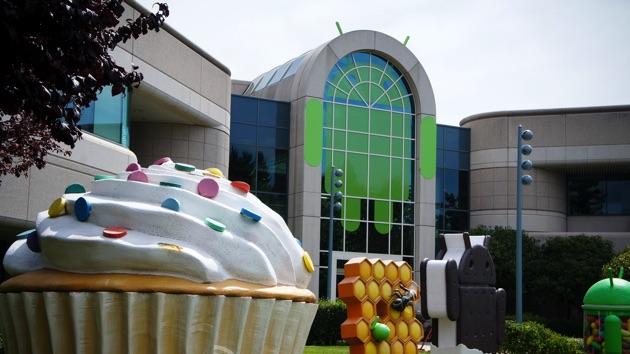
Google explains why it's not fixing web security in old Android phones
You might not be happy that Google isn't fixing a web security flaw in your older Android phone, but the search giant now says that it has some good reasons for holding off. As the company's Adrian Ludwig explains, it's no longer viable to "safely" patch vulnerable, pre-Android 4.4 versions of WebView (a framework that lets apps show websites without a separate browser) to prevent remote attacks. The sheer amount of necessary code changes would create legions of problems, he claims, especially since developers are introducing "thousands" of tweaks to the open source software every month.

Christmas brings 'Madden 15' demo to Xbox One and snow to 'GTA Online'
You know what goes really well together? Christmas and video games. This year we've noticed a bit of a trend: games giving away free stuff in light of the holiday. Weather, err, whether it's snow covering Los Santos in GTA Online, a six-hour trial of Madden or online multiplayer for Killer Instinct Classic, there's no shortage of goodies to keep your console (maybe you recently unwrapped a PlayStation 4 or Xbox One?) busy for the next few days. Let's recap, shall we? In addition to the aforementioned inclement weather southern San Andreas is experiencing, for a limited time you can don a gingerbread mask in GTA Online and start lethal snowball fights in addition to getting a few unspecified gifts for your inventory tomorrow.
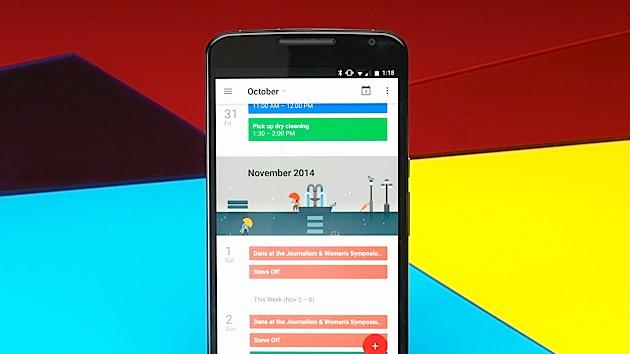
Lollipop isn't making a dent in Android usage numbers (yet)
Now that Android 5.0 Lollipop is finally rolling out to devices around the globe, you might be wondering just how much of an impact it's making on the Android ecosystem. The short answer: not much. Google has released its latest Android usage stats, and Lollipop doesn't even register yet -- in other words, less than 0.1 percent of Google Play users have moved to the new software. That's not surprising given that both the upgrade and Lollipop-native devices like the Nexus 6 are weeks old at best, but it suggests that the new OS will take a while before it makes its presence known.

KitKat is now running on more than 20 percent of Android devices
In case there was any doubt that KitKat now has a solid foothold in the Android world, Google just offered some proof. Its usage data for early August shows that KitKat is on more than a fifth of active Android devices, at 20.9 percent. That's a healthy improvement over July (17.9 percent), and a big leap over the 14.9 percent we saw in June. The folks in Mountain View aren't explaining the steady growth, but it's easy to figure out what's going on -- big-name devices like the LG G3 and Samsung Galaxy Tab S are bringing this latest OS flavor to a wider audience, and many older gadgets are still getting upgrades.

KitKat is now on nearly 14 percent of Android devices
You know how Apple was keen to point out that only 9 percent of Android users (technically, 8.5 percent) were running KitKat in May? Well, that figure's now out of date. Google has published fresh usage stats which show that 13.6 percent of Android owners are using KitKat as of early June. That's still far from a majority, but it represents a 60 percent jump in a single month. It's not hard to see why the newer OS would be making such big strides. Major new phones like the HTC One and Galaxy S5 have had more time on the market, and KitKat upgrades are still making their way to older gadgets.
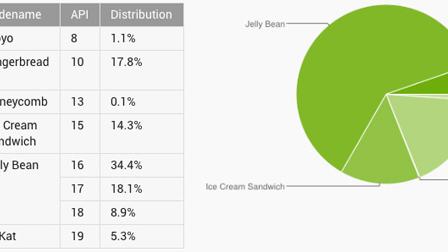
KitKat's share of Android devices more than doubles to 5.3 percent
After months of treading water, Android 4.4 KitKat is finally taking off. Google reports that 5.3 percent of Android users are running the newer OS version as of early April; that's more than twice the 2.5 percent that it claimed one month earlier. There's no official explanation for the jump, but it's most likely thanks to a wave of KitKat upgrades from HTC, LG and Samsung. Most older versions lost share as a result. It could be a long, long time before KitKat overtakes Jelly Bean (which dipped to 61.4 percent), but the transition is under way -- and it's only likely to accelerate now that flagships like the Galaxy S5 and new One are reaching store shelves.
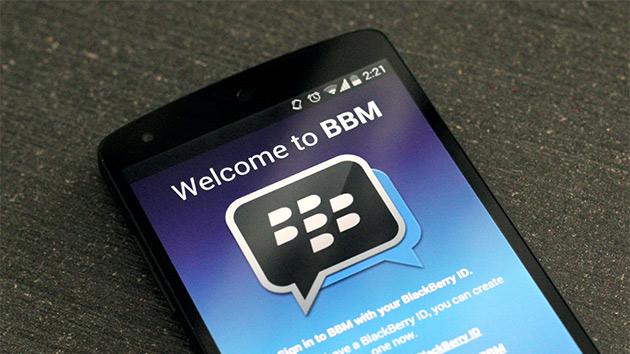
BlackBerry Messenger now available to phones running Android 2.3
If you see BlackBerry announcing a million or so new users in the next few days, it's not because the company's finally seeing an increase in sales. It's because Alicia Keys' ex-employer has kept its promise to launch BBM for Android 2.3 on Google Play after weeks of beta testing. The previous Android version of the cross-platform messenger only worked on devices running Ice Cream Sandwich (Android 4.0) or higher, but existing users can now reach more of their friends. After all, Gingerbread still powers a large number of Android devices worldwide, since low-cost handsets are especially popular in developing markets. Unfortunately, Windows Phone users still have to sit out BBM convos, but those in Canada can at least demand BlackBerry donuts from friends as consolation.

BlackBerry targets developing markets with Gingerbread BBM app
BBM for Android has been installed millions of times since its (bumpy) launch, but that's not enough for the folks in Waterloo. Today BlackBerry has confirmed what many already suspected: it's planning to launch a version of BBM for phones still running Android 2.3 in February. Those first versions only ran on Ice Cream Sandwich or later, and BlackBerry has been not-so-quietly scouting for Gingerbread beta testers for at least two weeks. It's not hard to see why the company wants to branch out further, especially since it's dealing with pressure from buzzy messaging apps like Snapchat and WhatsApp. And while it might feel ancient, Gingerbread still powers over a fifth of active Android devices. Lots of those phones are sold at cut-rate prices across the globe, so BlackBerry has a shot at maintaining its messaging mojo in developing markets... though pumping out cheap Foxconn-made phones should help too.
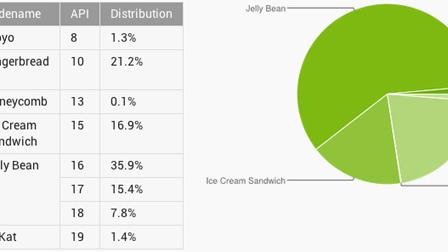
Jelly Bean claims 59.1 percent of Android device share as KitKat inches forward
Google has released its first Android device share data for 2014, and it's now clear that many users are flocking to a newer OS version... just not the latest version. While the shiny new KitKat release did climb to 1.4 percent of active devices in January, Jelly Bean was the real winner -- the older software jumped from 54.5 percent in December to 59.1 percent this month. There's no real mystery as to what happened, though. KitKat remains limited to mostly Google hardware, whether it's the Nexus line or Motorola phones; we haven't quite reached that point where large numbers of third-party devices either get KitKat upgrades or ship with the revision pre-installed. That surge may come soon, however, and the team in Mountain View can at least take comfort in knowing that over 60 percent of Android's active customer base is reasonably up to speed.

Vine for Android comes to Gingerbread phones, but only for viewing
Android fans running Gingerbread no longer have to sit out the Vine video craze. An updated Vine app now supports playback on the 2010-era Google OS, giving the many people using older Android phones a chance to see all the short clips they've been missing. They shouldn't expect to record clips, though -- Vine says that "device limitations" prevent Gingerbread users from creating their own content. That negates much of the app's reason for being, but the expanded support still represents a kindness toward those who'd otherwise be left out of the (video) loop.

KitKat claims 1.1 percent of Android device share a month after launch
KitKat may be the new kid on the Android block, but it's already faring quite well. Google's latest OS dashboard reveals that 1.1 percent of active Android devices are running the new platform roughly a month after it became available. Not that its arrival is slowing down Jelly Bean's growth, mind you. The older software now represents 54.5 percent of all Android use, thanks in part to a two-point surge in devices running Android 4.3. However well Jelly Bean is doing, we expect KitKat adoption to rise quickly -- both the Nexus 5 and the first official KitKat upgrades have only been around for a few weeks at most, and there are more updates on the way.

More than half of Android devices now run Jelly Bean
It may have taken almost a year and a half, but Google can at last say that the absolute majority of active Android devices are using some form of Jelly Bean. The company's OS dashboard shows that 52.1 percent of owners are running at least Android 4.1; most of those (37.3 percent of the total) rely on the oldest version, but Android 4.2's use has already doubled since August. Jelly Bean's reign may be short-lived, however. The milestone comes just as Android 4.4 KitKat is reaching the public -- given Google's focus on supporting as many devices as possible with the new OS, it may not be long before Jelly Bean is once again in the minority.

BLU Products launches trio of Dash smartphones starting at $49
Too thrifty to buy a $199 Nexus 4, or even a $99 Lumia 520? BLU Products has you covered with three new smartphones in its Dash range. The line starts with the Dash Jr., a 3.5-inch dual-SIM phone that costs just $49 unlocked -- cheap enough that we (almost) don't mind its single-core Spreadtrum processor, 2G-only data, 2-megapixel camera and Android 2.3. If you can afford to splurge, the Dash Music 4.0 ($99) and Dash 5.0 ($129) jump to their namesake larger screens, 3G data, dual-core MediaTek chips, higher-resolution cameras and Android 4.2. BLU expects all three Dash handsets to ship before the end of September, so penny pinchers won't have long to wait. Check out press shots of the Dash Music 4.0 and Dash 5.0 after the break.

Android's Jelly Bean contingent finally surpasses Gingerbread
It's a new era, we tell ya. An era where Google can finally say that its latest build of Android is also the one being used by the greatest majority of Android users. For over a year, Android 4.1+ has been the most up-to-date build of Google's mobile OS, and yet, the greatest majority of those accessing the Play Store were using a build that was bordering on antediluvian. According to the official Developers Dashboard, the percentages have slid to a point where Android Jelly Bean -- which encompasses 4.1.x and 4.2.x -- now represents 37.9 percent of Play Store users. Gingerbread (v2.3.3 through 2.3.7) has fallen to second place with 34.1 percent, while Ice Cream Sandwich (4.0.3 through 4.0.4) holds down the bronze with 23.3 percent. Hit up the source link to view the full breakdown, and do us a solid -- if you know someone still using Donut, grab 'em a Christmas-in-July present.




